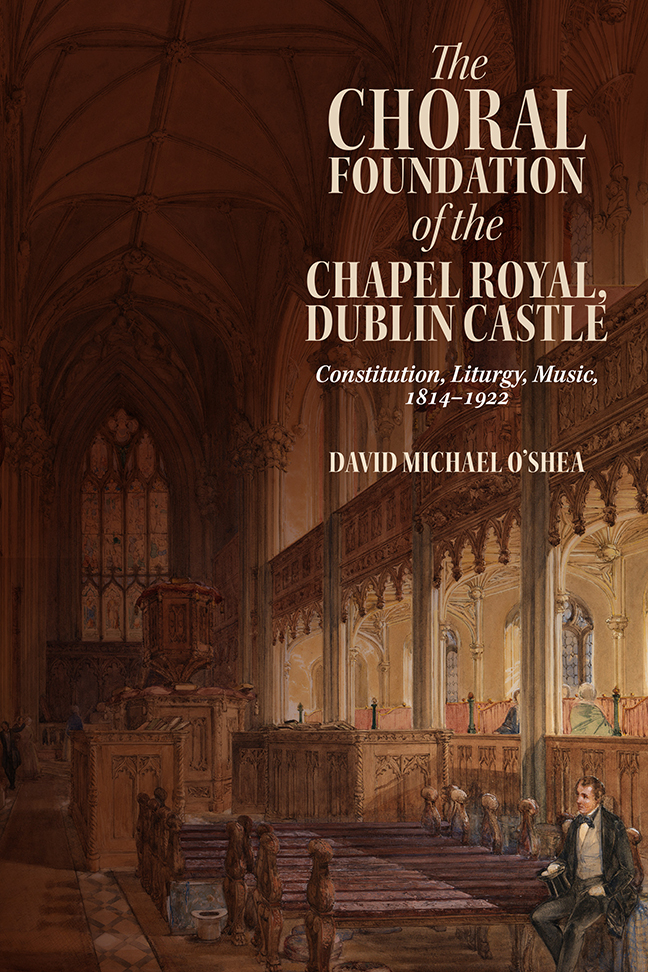Book contents
- Frontmatter
- Contents
- Illustrations
- Foreword
- Preface
- Acknowledgements
- A Note on Terminology
- Abbreviations
- Introduction
- 1 Precedents, Polity and Politics
- 2 Clergy
- 3 Churchmanship, Furnishings and Functions
- 4 The Musical Foundation
- 5 The Chapel Royal Music Collection
- 6 Singing the Liturgy
- 7 Organs
- 8 Boy Choristers
- 9 Gentleman Singers
- 10 Organists and Composers
- 11 The Chapel Royal's Legacy
- Conclusion
- Appendix A Lords Lieutenant, 1801–1922
- Appendix B Clergy of the Chapel Royal
- Appendix C Extant Chapel Royal Music Volumes (RCB MS 1113)
- Appendix D Boy Choristers of the Chapel Royal
- Appendix E Gentlemen Singers of the Chapel Royal
- Appendix F Organists of the Chapel Royal
- Appendix G Fragment of a Juvenile Chant by C. V. Stanford
- Bibliography
- Index
- Irish Musical Studies Previous volumes
3 - Churchmanship, Furnishings and Functions
Published online by Cambridge University Press: 10 January 2024
- Frontmatter
- Contents
- Illustrations
- Foreword
- Preface
- Acknowledgements
- A Note on Terminology
- Abbreviations
- Introduction
- 1 Precedents, Polity and Politics
- 2 Clergy
- 3 Churchmanship, Furnishings and Functions
- 4 The Musical Foundation
- 5 The Chapel Royal Music Collection
- 6 Singing the Liturgy
- 7 Organs
- 8 Boy Choristers
- 9 Gentleman Singers
- 10 Organists and Composers
- 11 The Chapel Royal's Legacy
- Conclusion
- Appendix A Lords Lieutenant, 1801–1922
- Appendix B Clergy of the Chapel Royal
- Appendix C Extant Chapel Royal Music Volumes (RCB MS 1113)
- Appendix D Boy Choristers of the Chapel Royal
- Appendix E Gentlemen Singers of the Chapel Royal
- Appendix F Organists of the Chapel Royal
- Appendix G Fragment of a Juvenile Chant by C. V. Stanford
- Bibliography
- Index
- Irish Musical Studies Previous volumes
Summary
Ecclesiastical architecture, churchmanship and liturgical practice
The Evangelical churchmanship of the eighteenth and early nineteenth centuries placed increased emphasis on the preaching of the Word, which led to a corresponding de-emphasis of liturgical worship. In many churches the services of the Book of Common Prayer became perfunctory preludes to lengthy sermons, and the central importance given to the sermon caused the sacraments of baptism and Holy Communion to be relegated to subsidiary positions. By the standards of other periods, baptism was administered in a cursory manner, often using not a font but an improvised bowl placed on the Communion table, and Holy Communion was celebrated only a few times a year. Such downplaying of the sacraments was reflected in architectural trends: the so-called ‘triple-decker’ pulpit (an imposing wooden structure which incorporated a minister's reading desk, a desk for the parish clerk, and a rostrum from which the sermon was preached; Plate 3) frequently occupied the most prominent position in the church and obscured the view of the Communion table.
In the early part of the nineteenth century, a number of movements for church reform began to gather pace. Liturgical reforms are often attributed to ‘Tractarians’ such as John Henry Newman (1801–90) and John Keble (1792–1866), the progenitors of the Oxford Movement, who received their nickname from the publication Tracts for the Times, issued between 1833 and 1841. These figures, however, were initially less concerned with liturgy and more with church polity and doctrine, though the emphasis they placed on the Catholic and Apostolic nature of the church inevitably led to an increased focus on sacramental worship. The development of ritualistic liturgical practices within the Church of England was frequently identified with Edward Bouverie Pusey, from whose name came the pejorative eponym ‘Puseyism’, a term used by Evangelicals to describe any liturgical innovations they found distastefully ritualistic.
The Cambridge Camden Society (later renamed the Ecclesiological Society) was the most influential outgrowth of the Oxford Movement to affect church architecture and liturgical practice. It was founded in 1839 by John Mason Neale and Benjamin Webb in order to promote the reform of church architecture for the better ordering of churches for sacramental worship, and the banishment of the still prevalent eighteenth-century ‘preaching-house’ ethos.
- Type
- Chapter
- Information
- The Choral Foundation of the Chapel Royal, Dublin CastleConstitution, Liturgy, Music, 1814-1922, pp. 55 - 76Publisher: Boydell & BrewerPrint publication year: 2023

